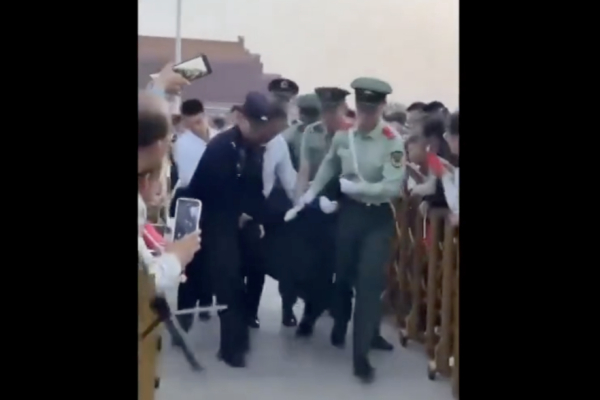In the early hours of June 2nd, during the closing moments of the flag-raising ceremony at Tiananmen Square in Beijing, a man in black suddenly climbed over the railing in an attempt to rush towards the national flagpole, instantly sparking tension throughout the venue. Surrounding security guards and plainclothes personnel swiftly tackled the man and escorted him away from the scene, loading him into a police car. Though the entire incident was brief, it drew a large crowd of onlookers, with many capturing this rare scene on their mobile phones.
At the time of the incident, it was just ahead of the anniversary of the June Fourth protests, and security measures in Tiananmen Square had been significantly heightened. There was a noticeable increase in security forces around the square, with everyone required to undergo strict identity verification and security checks. As the flag-raising ceremony attracted a large number of tourists to the square, the man’s sudden actions disrupted the calm atmosphere, quickly escalating into a tense situation.
Video clips circulating from the scene indicate that there seemed to be a designated “rapid response pathway” in the flag-raising area, directly connecting the flag fence to an Iveco police car. It was through this seemingly unguarded pathway that the man in black boldly entered the restricted flag-raising zone.
Furthermore, security personnel on-site not only included uniformed police and armed police officers but also many plainclothes police officers blending in with the crowd of flag-viewers, closely monitoring the situation.
Of note, the video also captured a moment where a police officer accidentally fell while leaping over the fence, highlighting the tense nature of the scene.
Currently, the identity, nationality, and specific motives of the man remain unclear. Authorities have not released any official statements regarding the incident yet. Given the timing of the event, it has immediately drawn widespread attention from the public.
Another netizen, “Chen Danqing,” remarked: “Truly daring to storm the tower, impressive! Who would have thought there are still such brave souls, knowingly heading towards danger like moths to a flame, like eggs hitting a rock, risking it all… even former revolutionaries are no different.”
User “Wu Pingqi” expressed: “After a century of slumber, the people of the nation are slowly waking up! Opening our eyes, moving forward bravely! It’s time to shatter the ‘eternal dream’ of the Chinese Communist Party.”
In recent years, on sensitive dates related to the Chinese Communist Party, security measures in major public spaces in Chinese cities have significantly intensified, particularly in Beijing’s Chang’an Avenue and Tiananmen Square, where precautions are taken as if facing a major threat.
As the political core landmark in Beijing, Tiananmen Square is under constant high alert, especially during sensitive periods such as “Two Sessions” and the June Fourth anniversary. Security deployments and surveillance measures escalate further during these times, with any abnormal behavior likely triggering swift responses.
Looking back in history, Tiananmen Square has witnessed several similar “sensitive incidents.”
On June 4, 2017, citizens across China commemorated the June Fourth Incident in various forms. Among them, Shanghai petitioner Hu Jianguo, Heilongjiang petitioner Ding Yajun, Hebei petitioner Zhao Chunhong, and Hubei petitioner Wang Shenhong engaged in performance art around Tiananmen Square to mourn the June Fourth students and uploaded photos of their activities online, resulting in their subsequent arrests by the police.
On October 28, 2013, a jeep abruptly drove into Chang’an Avenue in front of Tiananmen Square, dragged banners, and eventually crashed into the railing of Jinshui Bridge and caught fire, causing multiple injuries. Following the incident, the “Turkestan Islamic Party” claimed responsibility, leading to the dismissal of Lieutenant General Peng Yong in the Xinjiang Military Region, while Beijing bolstered its security measures.

